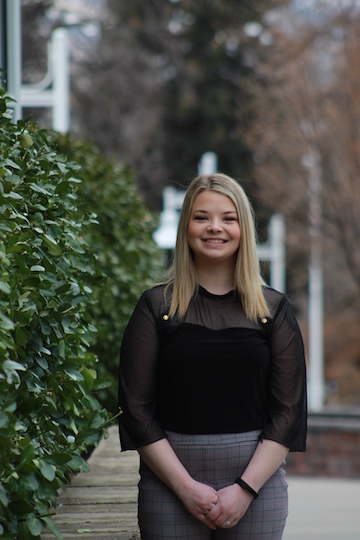Stories behind the science: Breaking barriers
January 21, 2021

Note: This story is one in a series of stories written by student Makenzie Kohler highlighting student scientists at Idaho State.
From an ear infection to meningitis, one germ is responsible and an Idaho State University student is helping solve the problem.
While taking a microbiology course at ISU, Hannah Aken became enamored with living creatures we cannot see with the naked eye- microbes.
“There's these little things, but you can't see them. You can't feel them, but they make you totally sick. They can kill you. They can ruin the ecosystem, they can mess with anything in our daily lives.” she said.
Aken's thirst for knowledge, specifically in studying pathogens (disease-causing microbes), pushed her to pursue scientific research. In the summer of 2019, Aken was accepted as a fellow into the Idaho Idea Network of Biomedical Research Excellence (INBRE) program, which is funded by the National Institutes of Health (NIH).
During the program, Aken studied the pathogen Streptococcus pneumoniae under Dr. Julia Martin at ISU. S. pneumoniae is a bacterium that in minor situations, causes an ear infection, but can be as severe as pneumonia and meningitis. Hannah specifically looked at the effects of magnesium, a transition metal, on the capsule of the bacterium. Magnesium has been found to be a structural component of the capsule. “The capsule is an outer coating that the bacterium forms in order to protect itself from being killed from the host's immune system,” she explains, “and so [the capsule is] harmful for us, because then it lets the bacteria live longer in our body.” By looking at how different quantities of magnesium impact capsule growth, Aken was able to determine that the more magnesium the bacteria had access to, the thicker the capsule. After 10 weeks of pipetting samples, growing cells, and performing assays, Hannah’s skills and confidence grew and her passion for microbiology was solidified.
Aken has since completed a second research internship and has presented at five different conferences across the U.S.
“One of the most enlightening feelings is going to a conference and being like, this is what I did. And being able to explain all of it, I mean, like, look at what I made, look at this thing. Like I did all this. And it's just so gratifying.” she says with a gleam in her eye. Hannah’s college experiences have led her on an exciting career path and her next adventure is charging head-on into a Ph.D. program.
It's an adventure that Aken didn't plan on when she started classes at ISU in 2017. Being the first person in her family to go to college, Aken faced the challenge of figuring out where to begin. Coincidentally, her best friend’s boyfriend at the time was in a program called TRIO on the ISU Pocatello campus. With the excitement of an “opportunity of no parents for seven weeks” during the summer before senior year of high school, the program was too much to pass up and Hannah joined.
“TRIO is a program that helps you get to and through college,” Aken said. “They have programs at the high school level that help first generation and low income or underrepresented students get to college or get to secondary education,” she continued. That seven weeks she had away from her parents was actually a research program for high school students called the SEED Internship. It was during this time that Hannah discovered her passion for science. And now she had the support she needed in order to pursue that passion.
Aken has applied to multiple graduate school programs in microbiology and immunology and currently has two offers for interviews. She applies in hopes to one day be able to become a primary investigator in her own lab studying pathogens and the human immune response to them. She is also excited to seek out opportunities to further nurture student’s interest in science and promote diversity at an institution with limited resources. Hannah, as she put it, went “blindly into college” and has since succeeded in every opportunity presented to her with the TRIO program by her side. In a few years, she just may be the person who helps reveal the inner workings of the microbe causing those pesky ear infections.
Categories:
